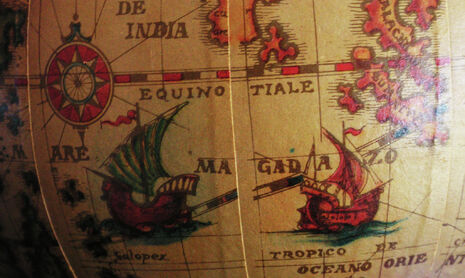Exhibition: Encounters – Money in the Age of Discovery
“If you are willing to spend 15 precious minutes of your busy day exploring the world of bygone money, then this exhibition will be a delightful experience”

The success of the expedition led by Christopher Columbus, who (at least officially) was the first European to set foot on American soil, has all too often made us forget the many expeditions made by others during the Middle Ages who reached unknown parts of the world. There was also the fabulous odyssey of Marco Polo, who followed the silk road to China, or the mystical voyage of Saint Brendan in the Atlantic, or the journey of the Chinese admiral Zheng. He and his magnificent fleet of 317 ships, holding almost 28,000 crewmen, made it all the way to Africa and (just possibly) America.
The reason we remember Columbus’s voyage, however, is that his was the prime mover of one of the greatest revolutions in economic history, while the other voyages above were merely symptoms of social development patterns which had already taken hold, with limited impact on the minds of contemporaries. This is nowhere more evident than in the Fitzwilliam Museum’s exhibition: Encounters: Money in the Age of Discovery. The exhibition departs from the established depiction of the encounter between the Old and the New World, having been separated by a chasm of time after Homo sapiens migrated out of Africa, as a bloody affair of colonialism hiding behind the all-too-thin veil of a civilisation mission. The exhibition takes the visitor through centuries of remarkable changes for human societies, all told through the prism of that delightfully abstract holder of value and objectified human labour: money.
If you are willing to spend 15 precious minutes of your busy day exploring the world of bygone money, then this exhibition will be a delightful experience. It is perhaps the best non-textbook crash course in the history of finance offered in Cambridge. The display holds a treasure trove of stories about the contrasting experiences of European colonies in different parts in the world. In the Americas and Africa, traditional forms of exchange gave way, quite bloodily, to European-style coins and later banknotes. The gold-thirst of Spaniards, who went deep into the Andes in their search for the mythical Eldorado, the city of gold, led them to discover the huge silver deposits the mountain held. The three Spanish silver coins in the exhibition tell the story of the brutal slave labour delivered by Inca people forcibly abducted to mine the ore needed to produce those coins. Their rugged, asymmetric shape is a tactile suggestion of the fact that the coin’s value was derived from its quality of metal rather than what was written on it. Those irregularities are also suggestive of the greed of the conquistadores who launched them into circulation, impatient to exchange them for luxury and riches.
Taking a trip in financial history on a busy Cambridge afternoon would be overwhelming were it not for the remarkable conciseness of the collection. While all the artefacts are absolutely worth their while, an inquisitive visitor will find that their curiosity has only been stirred but by no means satisfied. However, there are ample ways to explore the topic further, and the exhibition provides an excellent introduction to a world of conquest, adventure, unbridled brutality and greed.
 Features / Should I stay or should I go? Cambridge students and alumni reflect on how their memories stay with them15 December 2025
Features / Should I stay or should I go? Cambridge students and alumni reflect on how their memories stay with them15 December 2025 News / Cambridge study finds students learn better with notes than AI13 December 2025
News / Cambridge study finds students learn better with notes than AI13 December 2025 News / Dons warn PM about Vet School closure16 December 2025
News / Dons warn PM about Vet School closure16 December 2025 Comment / The magic of an eight-week term15 December 2025
Comment / The magic of an eight-week term15 December 2025 News / News In Brief: Michaelmas marriages, monogamous mammals, and messaging manipulation15 December 2025
News / News In Brief: Michaelmas marriages, monogamous mammals, and messaging manipulation15 December 2025








